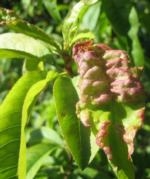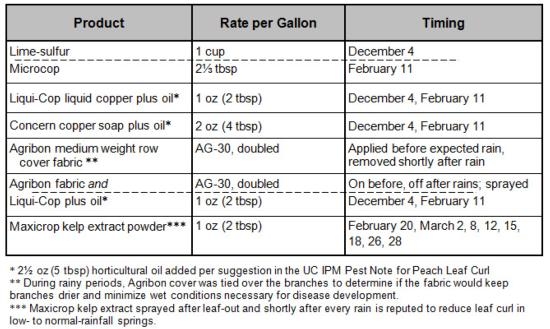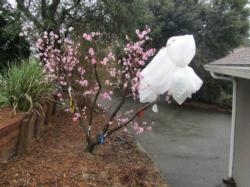Peach Leaf Curl and the Drama That Unfolds
This year was a tough year for the peaches and nectarines. It seemed that even though we sprayed with a copper oil spray and with a registered fungicide at the right time, the PLC was very noticeable on the trees this spring. Treating now is useless as is pulling off the infected leaves. Never the less, many people do it because it makes them feel better and they don't see the infected leaves anymore. Chuck Ingles on the other hand is trying to do something about it! He has been working on methods that home gardeners may use to thwart PCL withouit the use of the chemical recently removed from sale to home gardeners, specifically Lime Sulfur and the copper fungicide Microcop. The only fungicide products left for treating peach leaf curl are those containing lower levels of copper (such as Liqui-Cop), copper soap, and the non-copper synthetic fungicide chlorothalonil. Because the level of copper is quite low in these products they are not as effective as Microcop was. Chuck conducted the trial at the Fair Oaks Horticulture Center demonstration orchard (and one tree in a private yard) to determine what works best for controlling peach leaf curl now that the most effective products are no longer available.
The treatments that Chuck used included: Lime sulfur, Liquicop, Concern Copper Soap Plus Oil, Agribon medium weight row cover fabric, Agribon plus Liquicop, Kelp Extract
The results: Compared to untreated branches, those treated with Liqui-Cop averaged about 70% control, copper soap 80% control, and Agribon by itself just under 60% control, but these treatments were not statistically different. Agribon generally kept the branches dry, although some moisture was evident after heavy rains. Two treatments provided nearly
complete control: (1) Agribon plus Liqui-Cop, and (2) lime sulfur (late fall) followed by Microcop (late winter). Maxicrop (kelp) did not work at all and substantially increased the severity on some of the branches.Conclusion:
The two liquid copper products have fairly similar efficacy—they improved control and perhaps sufficiently, but still not great. The control achieved, although resulting in some unsightly damage, is probably enough to allow the tree to produce good shoot growth with enough healthy leaves to nourish the rapidly growing young fruit. Agribon likely allowed some rain to penetrate to the branches. It may be best held up with a post in the middle to allow rain to run off down the sloped sides rather than having a flat surface on top, but it must be fastened securely because of strong winds. Agribon plus Liqui-Cop worked quite well, probably because the fairly good control with Liqui-Cop was enhanced by drier conditions. The combination of lime sulfur (in late fall) followed by Microcop (in late winter) was highly effective, as expected. Normally only one of these products was used for both fall and winter applications, but insufficient product was available for both. Maxicrop (kelp), even sprayed eight times, provided no control at all.
For more details on Chuck Ingels Peach Leaf Curl Trials, go to the Sacramento County Website at: http://cesacramento.ucdavis.edu/Pomology/____Tree_Fruit_Crops/2012_Peach_Leaf_Curl_Trial_at_the_Fair_Oaks_Horticulture_Center/
Comments:
I'm thinking about certification for my farm. Can I get certified if i'm using Liqui-Cop as a dormant spray on my fruit trees? My understanding it that it is considered organic, but not on the OMRI approved list.
Thanks,











Posted by Michael Anne Foley on May 1, 2012 at 10:26 PM